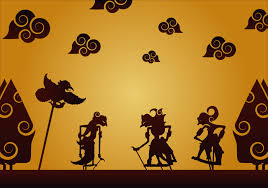Wayang kulit is a traditional Indonesian art that mainly developed in Java. Wayang comes from the word “Ma Hyang” which means leading to a spiritual spirit, deity, or God Almighty. There are also those who interpret wayang as a Javanese term meaning “shadow”, this is because the audience can also watch wayang from behind the screen or only the shadow. Wayang kulit is played by a dalang who is also the narrator of the dialogue of the puppet characters, accompanied by gamelan music played by a group of nayaga and songs sung by singers. The dalang plays wayang kulit behind the screen, which is a screen made of white cloth, while behind it an electric lamp or oil lamp (blencong) is illuminated, so that the audience on the other side of the screen can see the shadow of the puppet falling onto the screen. To be able to understand the wayang story (play), the audience must have knowledge of the wayang characters whose shadows appear on the screen. In general, wayang takes stories from the Mahabharata and Ramayana scripts, but it is not limited to these standards, the ki dalang can also play carangan plays (compositions). Some stories are taken from the Panji story. The shadow puppet show was recognized by UNESCO on November 7, 2003, as an amazing cultural work in the field of narrative stories and beautiful and precious heritage (Masterpiece of Oral and Intangible Heritage of Humanity). Wayang kulit is more popular in central and eastern Java, while wayang golek is more often played in West Java.
Definition of shadow puppets
Indonesian traditional art which mainly developed in Java. In general, wayang takes stories from the Mahabharata and Ramayana scripts, but it is not limited to these standards, the ki dalang can also play carangan plays (compositions).
The history of shadow puppets
Judging from existing history, the origin of wayang is considered to have existed since 1500 years BC. Wayang was born from the scholars of the Javanese ancestors in the past. The oldest wayang kulit ever found is thought to date from the 2nd century AD.
The origin of the shadow puppet
The traditional performing arts of wayang kulit are identical to Javanese culture. Wayang kulit is indeed widespread in the Java region, precisely in Central Java and East Java. The word wayang itself is known to come from ‘Ma Hyang’ which means to go to spiritual spirits, gods, or the power.
Shadow puppet founder
His real name is Joko Said who was born in 1450 AD. The shadow puppets that exist today are the innovations of Sunan Kalijaga.
Puppet function
• The function of wayang kulit in the life of the people of Demak is as a medium of entertainment, education, information, art, philosophical understanding, propaganda media and others.
• as an effective medium in conveying messages, information and lessons. Wayang used to be used as an effective medium in spreading religions ranging from Hinduism to Islam. Because the wayang is so flexible, until now its existence is still strong and is used for various purposes.
The origin of the shadow puppet
Wayang was born from the scholars of the Javanese ancestors in the past. At that time, puppets were thought to only be made of tied grass, so the shape was still very simple. Puppets are played in ancestral spirit worship rituals and in Javanese traditional ceremonies
Puppet making
Wayang kulit is made from cowhide that has been processed into sheet leather, each puppet requires about a size of 50 x 30 cm of sheet leather which is then carved with the equipment used is pointed iron made of good quality steel. This steel is made in advance in various shapes and sizes, there are pointed, flat, small, large and other shapes, each of which has a different function.
But basically, to arrange or make various forms of carving holes that are intentionally made to be hollow. After that, the body parts such as the hands are installed, in the hands there are two connections, the upper arms and elbows, how to connect them with small screws made of buffalo or cow horns. The stalk whose function is to move the blackish part of the arm is also made from buffalo horn material and its golden color is generally using prada, namely gold colored paper that is pasted on or it can be dibron, painted with melted powder. Puppets that use prada, the results are much better, the colors can last longer than the bront ones.
Types of shadow puppets by region
• Cengkok Kedu Shadow Puppet
• Wayang Kulit Gagrag Yogyakarta
• Wayang Kulit Gagrag Surakarta
• Wayang Kulit Gagrag Banyumasan
• Wayang Kulit Gagrag East Java
• Balinese Puppet
• Banjar Shadow Puppet (South Kalimantan)
• Palembang Puppet (South Sumatra)
• Betawi Puppets (Jakarta)
• Cirebon Shadow Puppet (West Java)
• Madurese puppets (extinct)
• Siamese Puppets (Kelantan, Malaysia)
The need for digital IT is needed in daily activities, Bead IT Consultant is the right choice as your partner, visit our website by clicking this link: www.beadgroup.com

